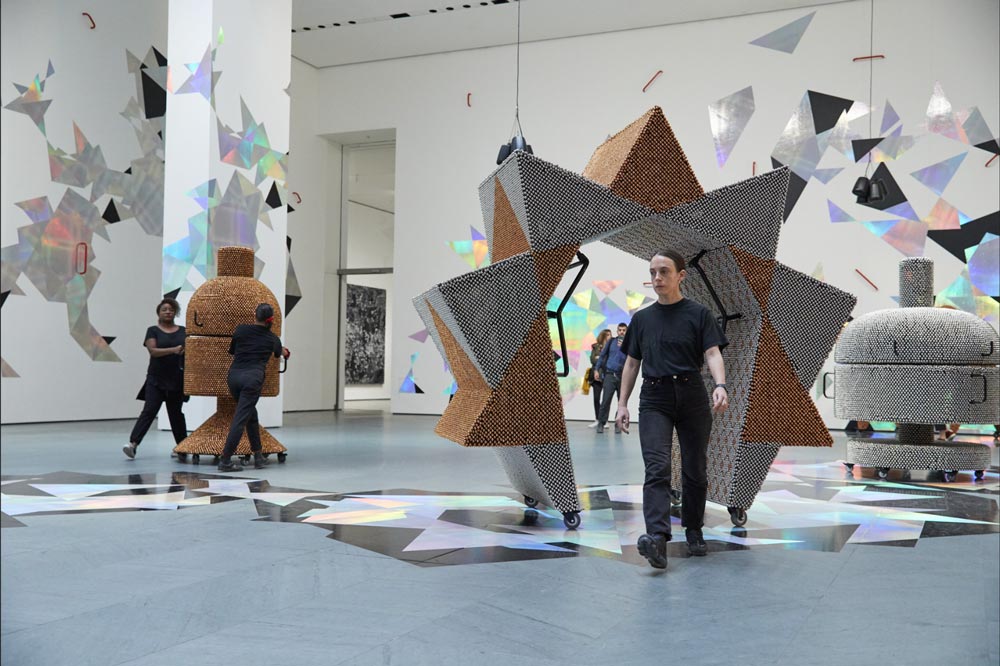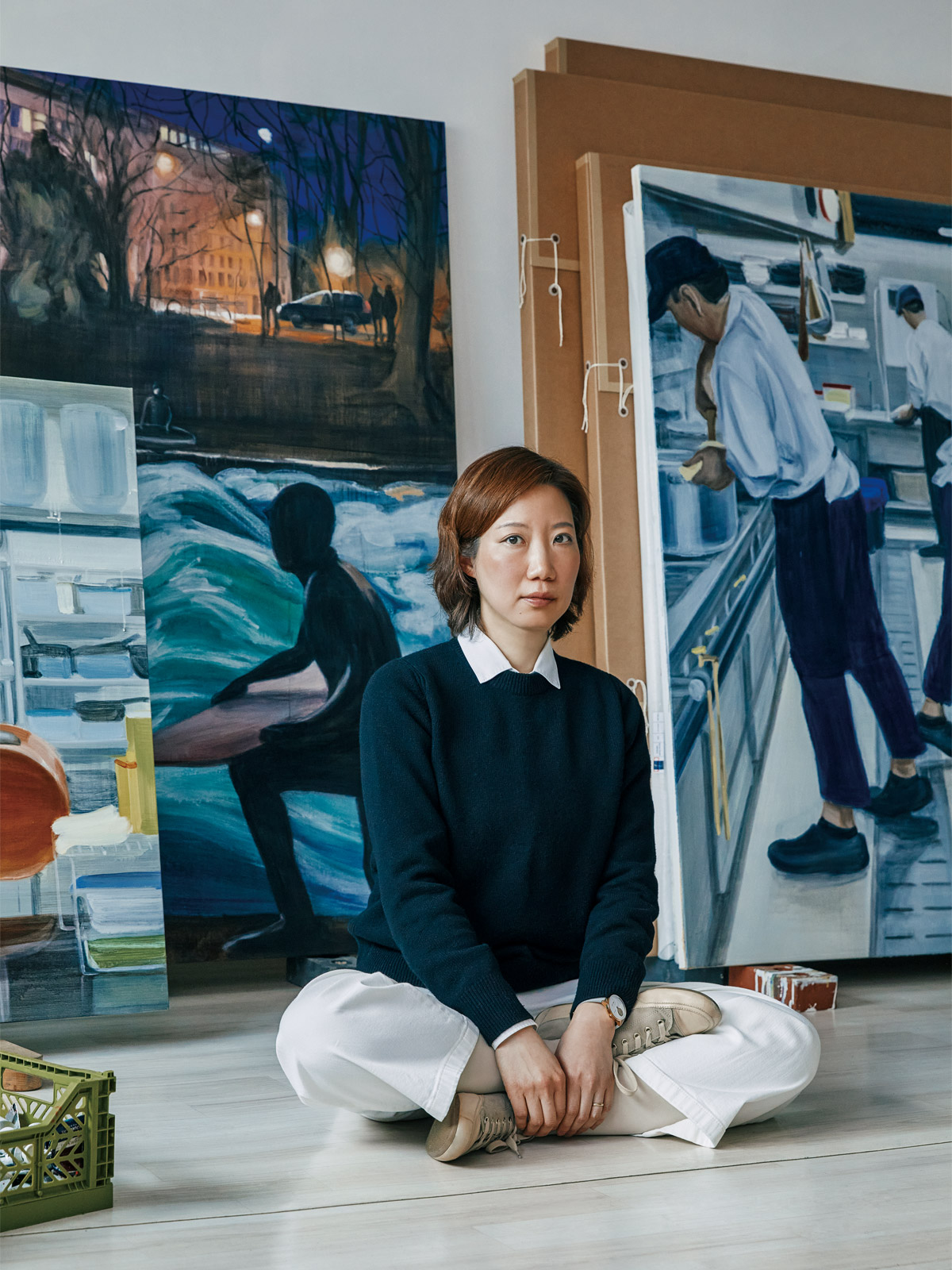Haegue Yang (b. 1971), who works and lives in Berlin and Seoul, is one of the most prominent contemporary artists working in Korea today. In 2018, she became the first Asian female artist to win Germany’s prestigious Wolfgang Hahn Art Prize, and in 2022, she became the first Korean to win the Benesse Prize.
Encompassing a variety of media, from collage to performative sculpture to space-filling installations, Yang’s work connects histories and traditions that have no parallels into a unique visual language. The artist utilizes a variety of craft techniques and materials, from blinds to drying racks, Korean paper to artificial straw, to capitalize on their inherent cultural qualities. By creating multisensory and immersive environments that activate perception beyond sight, Yang provides an immersive experience that addresses issues such as labor and migration from an aesthetic perspective.

Haegue Yang, Storage Piece, 2004 ©Leeum Museum of Art
Yang’s early work, Storage Piece, which established her international recognition, reflects the artist’s early years as a stranger. In 2003, while in London for an artist residency program, she gathered all of the works that had been returned to her and had no place to store them, and composed a body of work under the name “Storage Piece.” The work, which consisted of thirteen artworks stacked on four wooden shipping pallets, still in their original carrier packaging, was first shown in the UK and has since been exhibited in Darmstadt, Berlin, São Paulo, Amsterdam, and Hanover.
In 2004, The Storage Piece was acquired by a German collector, marking a new phase in the artist’s career. In 2007, the collector suggested holding the exhibition “Unpacking Storage Piece,” which unpacked the various pieces from the packaging, which was an important opportunity for the artist to make her work more widely known. In 2008, she was named one of the world’s top 100 media installation artists by the German magazine ‘Capital’ with artist Lee Bul.
 Haegue Yang, Series of Vulnerable Arrangements – Voice and Wind, 2009, Installation view at 53rd Venice Biennale. Photo: Pattara Chanruechachai. ©Haegue Yang
Haegue Yang, Series of Vulnerable Arrangements – Voice and Wind, 2009, Installation view at 53rd Venice Biennale. Photo: Pattara Chanruechachai. ©Haegue YangFor Yang, ‘space’ is an important element, and her signature series of blind installations, Series of Vulnerable Arrangements, illustrates the artist’s view of space. Blinds are often used to create a boundary between the outside and the inside, but in fact, the boundary created by blinds does not divide the space as perfectly as a wall, but only creates a temporary translucent division.
The artist explains that a state that is bounded but not bounded can never be a complete whole, and the space she creates through her installation is more of an incomplete state, a space in the abstract.
Among the Series of Vulnerable Arrangements series, Series of Vulnerable Arrangements – Voice and Wind, which was first exhibited at the Korean Pavilion at the 53rd Venice Biennale in 2009, was permanently acquired by the Guggenheim Museum, one of the world’s leading museums.
 Installation view of “Haegue Yang: Handles” at Museum of Modern Art, New York (2019-2021). Photo: Heidi Bohnenkamp. ©Museum of Modern Art (MoMA)
Installation view of “Haegue Yang: Handles” at Museum of Modern Art, New York (2019-2021). Photo: Heidi Bohnenkamp. ©Museum of Modern Art (MoMA)In 2013, Yang began working on the series Sonic Sculptures, which centers on the material of ‘bells’. In her series, she experiments with the characteristics of bells, which produce sound only when they are moved by an external physical force. For example, some of the pieces are made in the form of clothing and generate sound when worn and moved, while others are equipped with wheels and handles that make sound when moved. The audiovisual effects of these different ways of making sound lead the viewer into an immersive experience.
Yang explains ‘bell’ as follows. “The bell evokes the universal human experience of shaking or tapping a hollow object, extending the state of silence and immobility into sound and invocation,” and “represents the transition from nature to culture, the combination of culture and industry, which is replaced by craft and mass production.” In other words, for Yang, the bell functions not only as a medium for sound-installation, but also as a material that reflects folklore and civilization.

Installation view of “Haegue Yang: Shooting the Elephant 象 Thinking the Elephant” at Leeum Museum of Art in 2015 ©Leeum Museum of Art
Since 2015, the artist has been working on a new series of works titled The Intermediates, which begins with the question “What is folklore?” and uses straw grass crafts throughout. The artist notes that folklore is both individual and specific to each civilization, but also universal.
For example, handicrafts using straw have been traditionally practiced in many countries. By utilizing the folkloric but common material of straw and the methodology of straw crafts, the artist approaches the dimension of hybrid cultures, where similarities and differences are overlapped.
On the other hand, the material used in The Intermediates is not natural straw but artificial straw. The artist has previously used artificial materials that are industrial reproductions of nature, which satirically reflects the modern environment where nature is cheaply and easily imitated and replaced, and paradoxically introduces organic materials, crafts, and even memories of nature that are originally implied by industrial substitutes that have been forgotten through everyday consumption.
Referencing various cultural and religious buildings, Yang arbitrarily scales down actual structures, builds skeletons out of prefabricated aluminum structures, and shapes them by weaving and covering them with artificial straw. These works are ‘in-between’ performances that do not merely mix disparate elements, but create gaps to enter and mediate between them. The Intermediates creates a momentary collision between alien and familiar emotions, and raises awareness of new hybrid time and geographical zones.

Installation view of “Haegue Yang: Come Shower or Shine, It Is Equally Blissful” at Ullens Center for Contemporary Art (UCCA) in Beijing (2015). Photo: Tang Xuan. ©Haegue Yang
Since 2006, Yang has been developing blind installations as a major body of work for more than a decade, and has been working on the iconic Sol LeWitt Upside Down (2015-), a reinterpretation of American minimalist and contemporary art master Sol LeWitt’s (1928-2007) Modular Structures. The series is made by hanging Sol LeWitt’s original sculpture upside down and adjusting the width of the blinds to 70 centimeters at a time, which is a principle of Minimalist artists, applying the artist’s randomly specified criteria.
By following Sol LeWitt’s modular structure, Yang transforms the material of blinds into a tool that not only creates a new object, but also preserves a different way of being. At the same time, it frees the artist from the obligation or responsibility to create or create, and turns it into a way of documenting and reflecting on an already existing way of thinking.
The blind sculpture series has also been interpreted as a critical commentary on art history, which has limited minimalist or monochromatic working methods to Western normative canon rather than universal phenomena.
“Haegue Yang’s art is a true choral art, in which the most trivial oddments and the most profound themes of modernist art are amplified through a play of echoes and mutual resonances.” – Nicolas Bourriaud

Artist Haegue Yang. Photo: Ahn, CheonHo. ©Kukje Gallery
Haegue Yang moved to Germany in 1994 and received her Meisterschuler degree from the Städelschule in Frankfurt. She is currently a professor at her alma mater, and in 2018, she became the first Asian woman to receive Germany’s prestigious Wolfgang Hahn Art Prize. She has held solo exhibitions at leading institutions around the world, including the Helsinki Art Museum (2024), National Gallery of Australia, Canberra (2023), S.M.A.K., Ghent (2023), Pinacoteca Museu de São Paulo (2023), SMK Copenhagen, Denmark (2022), Tate St. Ives (2020), and MoMA, New York (2019).
Having exhibited solo at the Korean Pavilion at the Venice Biennale in 2009, Yang has continued to participate in major international exhibitions such as the Sydney Biennale and the Liverpool Biennale (2018), the 12th Sharjah Biennale (2015), the Taipei Biennale (2014), the Documenta (13), Kassel (2012), and the Gwangju Biennale (2010). Her work is currently in the collections of major national and international museums, including the MoMA, New York, the Guggenheim Museum, the Walker Art Center, the Tate Modern, and the Centre Pompidou, Paris.
In fall 2024, the first exhibition to examine the artist’s two-dimensional work as a sculptor will open at the Art Club of Chicago. This will be followed in October by a 120-piece survey exhibition at the Hayward Gallery in London as well.

























